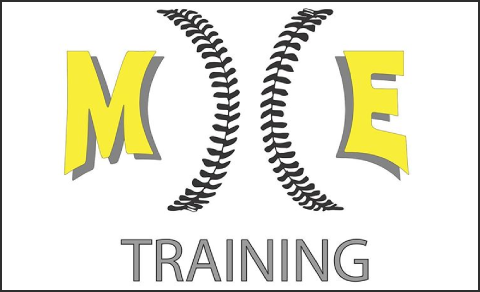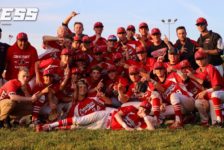On Friday, we had coverage of Prep Baseball Report’s Long Island showcase at All-Pro Field House. The event featured 70 players showcasing their abilities. Below is a breakdown of the top performers.
Position Players:
Kyle Rausch (Longwood 2019)
Kyle Rausch (Longwood 2019) pic.twitter.com/r1jsWZen00
Axcess Baseball LI (@axcessbaseball) February 23, 2018
Rausch’s older brother, Sean, is currently the Hofstra RF, and he certainly appears to have the makings of a Division-I athlete. The first thing that stood out to me was the violent contact he consistently made. It was clear he was well-ahead of the typical high school junior. My eye test was confirmed from the exit velocity reading of 94 MPH off the tee. This is an exceptionally strong player, eclipsing the second best by 9 MPH. He really had terrific balance at the plate and he got full extension with his hands that allowed him to generate line drives that would be extra-base hits in games. Defensively, he is an outfielder that was clocked at 84 MPH on his throws. This is a player with an extremely high ceiling, and he still has time to fill into his frame.
Kevin Bowrosen (Miller Place 2020)
The Miller Place sophomore brings a lot to the table. Despite a very thin frame (5’11” 170 lb) he makes the most of his body. At the plate, he is rhythmic hitter that gets the barrel on the ball consistently. He has exceptional hand-eye coordination which makes him a difficult out. As he puts on more mass, his line drives may develop into home runs. Defensively, he is well above-average. He has soft hands, athletic movements with his feet and a strong, accurate arm that was clocked at 87 MPH across the infield. On the mound, he touched 86 MPH with his max-effort delivery. He showed a 67 MPH curve and had great command. He is definitely a two-way prospect but with his advanced defensive skills, I think that part of his game that impresses the most.
Thomas Verga (William Floyd 2020)
Verga recorded the second highest exit velocity at 85 MPH. Like Rausch, he was impressive in terms of his ability to make loud contact. He was consistently in good hitting position. Defensively, he is very athletic for his size with soft hands, and a strong arm that was clocked at 79 MPH. He has a very high ceiling and currently has a high floor.
Manny Ariza (Perkiomen School)
The Pennsylvania native is solidly built at 5’8″ 218 lbs. He made solid contact consistently with his lefty approach. He also showed the ability to drive the ball to left-center field in his round of BP. Defensively, he had very smooth hands at first base with strong throws across the infield to third base. With his size, his athleticism was not on par with some of the other players but more than made up for it in the other facets of the game. He also was impressive on the mound, sitting 78-79 MPH from the left side with great arm side tail on his two-seam. He showed a 67 MPH curve with arguably the sharpest bite of the day. His 70-72 MPH had horizontal movement and fade as well.
Dante DiMarco (Calhoun 2020)
DiMarco put on an impressive showing in all facets; during his BP round, running the 40-yard dash, defensively at SS and defensively behind the plate. His 2.1 pop time was quick but he also made accurate throws to second. While at SS, he showed quick feet, soft hands and an accurate 78 MPH throw across the diamond. Offensively, he attacked the ball and made solid contact.
Pitchers:
Robert Milopsky (Rocky Point 2019)
Milopsky really stood out for his polished delivery and command of three pitches. He has an effortless delivery, he sat 83-84 MPH while touching 86 MPH with his fastball but it is a difficult pitch to square up considering the amount of tail on his two-seamer. His slider was 71-72 MPH and multiple observers behind the plate were impressed with the sharp bite on it. That is a strikeout pitch at the varsity level. His change up was in the same velocity range and he was able to throw it from the same arm slot and speed. He is very composed, he looks like the complete package on the mound.
Brian Silverio (Ward Melville 2021)
Brian Silverio (Ward Melville 2021) will be very dangerous on right-handed batters with his low 3/4 slinging delivery pic.twitter.com/J8iRTwrb3m
Axcess Baseball LI (@axcessbaseball) February 23, 2018
Ward Melville has consistently produced more elite-level prospects than just about any school on Long Island. They have had three pitchers drafted in the past decade and could have more in the near future. Silverio is extremely young, but has an extremely high ceiling. Typically pitchers from his low 3/4 arm angle sacrifice velocity for deception and movement but this freshman showed the velocity as well. He is only 160 lbs so he is only scratching the surface of his potential. His lightning-quick arm action shows that he will make a velocity jump as he puts on more mass. He sat 76-77 MPH with a 70 MPH change up and 64-66 MPH sweeping breaking ball.
Charlie Cucchiara (East Meadow 2019)
Charlie Cucchiara (East Meadow 2019) showed tremendous command of three pitches pic.twitter.com/0FN8xAJiQW
Axcess Baseball LI (@axcessbaseball) February 23, 2018
Despite not having the overpowering fastball, Cucchiara caught my eye for other reasons. He has a very clean delivery and he may have displayed the best command of the group of pitchers. He sat 78-79 MPH and touched 83 MPH but every fastball was down in the zone and on the corners. He showed a 61 MPH curve and 68 MPH change up. With that type of repeatable mechanics and command of the fastball, he will win a lot of games at the varsity level and is an appealing arm for colleges.
Patrick Jarvis (Manhasset 2021)
Patrick Jarvis (Manhasset 2021) touching 84 MPH pic.twitter.com/toteZt0HXY
Axcess Baseball LI (@axcessbaseball) February 23, 2018
Jarvis turned heads when he touched 84 MPH with his fastball. For a freshman, that is a least 10-12 MPH ahead of the median velocity. He has very impressive mechanics, he really utilizes his entire body and that is rare for a young pitcher. His over-the-top arm slot is conducive to sharp curveballs. He also performed well defensively at SS with his athleticism and strong arm but there’s no doubt the velocity/mechanics on the mound makes him a high-follow already.
Matt Polistino (John Glenn 2020)
Polistino may only be 5’9 155 lbs but he maximizes that with his delivery. He has a lightning-quick arm action and is able to sit 78-79 MPH while touching 80 MPH. He was consistently around the strike zone and has a 14 MPH difference in his change up at 66 MPH with the same arm speed. As he grows and puts on weight, that velocity can see a significant jump.
Steven Mazza (Archbishop Molloy 2022)
The youngest player in the event was very impressive. Only an eighth grader, but already 5’10”, Mazza turned heads with his 77 MPH fastball. That is extremely advanced for his age and almost at the nationwide average velocity for a varsity player. His mechanics were very clean. I really was impressed with his stride length and the extension he got. Young pitchers tend to be much more focused on their arm speed than their finish. Mazza wa also able to throw strikes consistently, showing that he was not overwhelmed by the moment. His curveball was 60 MPH and his change up was 68 MPH.
Robert Ray (Bayport-Blue Point 2018)
Ray caught the attention of the staff when he hit 87 MPH on his outfield throws. That velocity translated to the mound as he sat 83-84 and touched 85 MPH from the left side. He has an unconventional delivery as well which will definitely not be comfortable for hitters. After his balance point and during his decent to the plate, his leg hangs significantly longer than normal. This disrupts the hitters timing and considering his above-average fastball, this will generate plenty of swings-and-misses or weak contact. His change up was 75 MPH, which is closer to the velocity of a left-handed fastball. He did struggle with his command, but he did turn heads with his velocity.
Jai Sharma (Smithtown East 2020)
Despite not having one of the top velocities (sat 74-75 MPH), Sharma makes the list for his pitchabiity. He had one of the best curveballs at the event at 64 MPH and he also has a change up in the same velocity range with late drop that is dangerous on varsity hitters. He also throws both pitches from the same over-the-top arm slot and speed which makes it indistinguishable to pick up. He is only 150 lbs, so the velocity should jump up this year.
Mike Esposito (The Gunnery School 2018)
Esposito was consistently in the 83-84 MPH range which puts him in the range of a Division-I left-handed pitcher. His change up was 74 MPH. He did struggle with his command, often missing up-and-away to right-handed batters, but improved as he got more comfortable. His mechanics are clean, which leads me to believe there’s plenty of untapped potential still.
Noah Eisel (Oceanside 2019)
Eisel was impressive with the bat, but I think his best performance was on the mound where he sat 79-80 MPH with the fastball and showed a 73 MPH knuckleball that he commanded very well. He also threw a 75-76 MPH change up for strikes. He was consistent throwing strikes.
Jackson Sattinger (Paul D. Schreiber 2020)
Sattinger was one of the best left-handed pitchers in attendance. He’s a lanky 5’11” 150 lbs, but he was 77-79 MPH and he threw strikes from a deceptive low 3/4 arm angle. He had great command and he throws from the far first base side of the rubber which makes it very uncomfortable for left-handed batters. He showed a 62 MPH curveball and he threw a 71-72 MPH change up. Plenty of more velocity in him as he puts on weight in the next year or so.











